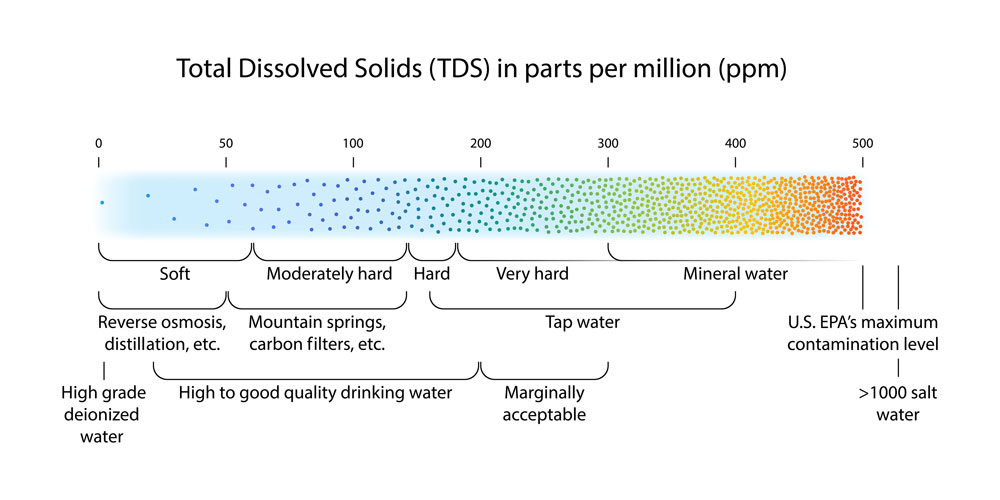Product added to cart
- Home
- Pure Water Blog
- What's the Normal TDS for Drinking Water?

Ever wondered what that number on your fancy water filter means? Or worried your tap water might be "impure" because it tastes different than bottled water? Relax, you're not alone! Today, we're diving deep into the world of Total Dissolved Solids (TDS) and uncovering the normal range for safe drinking water.
What is TDS?
Imagine a cup of tea. The tea leaves, sugar, and milk are all dissolved solids, contributing to the overall taste and composition of the drink. Similarly, TDS in water refers to the amount of minerals, salts, and organic matter dissolved within. It's measured in milligrams per liter (mg/L) or parts per million (ppm).
Is there a "normal" TDS level?
Unfortunately, there's no single "perfect" number. The ideal TDS range for drinking water depends on several factors, including:
- Location: Natural mineral content in water sources varies globally.
- Health guidelines: Different countries and organizations have set their own acceptable limits.
- Personal preference: Some people prefer the taste of water with higher mineral content, while others find it unpalatable.
Here's a general guideline:
- World Health Organization (WHO): recommends a TDS below 300 mg/L for pleasant taste and to avoid potential health concerns from excessive minerals.
- US Environmental Protection Agency (EPA): sets a secondary maximum contaminant level of 500 mg/L based on aesthetics, not health risks.
- Bureau of Indian Standards (BIS): permits TDS up to 500 mg/L but recommends below 200 mg/L for better taste.
Remember: TDS doesn't tell the whole story about water quality. Harmful contaminants like lead or arsenic can be present even in low TDS water. Regular testing for specific contaminants is crucial.
What if my water's TDS is outside the range?
- High TDS (above 500 mg/L): Might affect taste, but generally not a health risk unless specific contaminants are present. Consider filtration options like reverse osmosis if taste bothers you.
- Low TDS (below 50 mg/L): Can lack essential minerals. Check if your water treatment process removes beneficial minerals and consider adding them back through mineral drops or filters.
Key Takeaways:
- TDS measures dissolved minerals in water.
- Ideal range varies depending on location, guidelines, and taste preferences.
- WHO recommends below 300 mg/L, US EPA allows up to 500 mg/L.
- TDS alone doesn't guarantee safety; test for specific contaminants.
- High TDS might affect taste; low TDS might lack minerals.
Stay informed, make informed choices! By understanding TDS and its limitations, you can make better decisions about your drinking water and ensure you're staying hydrated and healthy.
Bonus Tip: Invest in a home TDS meter for quick checks and peace of mind. Remember, regular testing and consulting with water quality experts are essential for making informed decisions about your drinking water.
Related Products
Recent Posts
February 02, 2024
What's the Normal TDS for Drinking Water?
February 02, 2024
Unveiling the Most Accurate TDS Meter: Your Guide to Crystal-Clear Water Testing (2024 Update)
October 21, 2023
NPT vs. BSP Thread Types and Dimensions: A Comprehensive Guide
Archive
Tags
water purification
reverse osmosis
water filtration
water quality
drinking water
water contaminants
water treatment
clean water
RO system
water pressure
post-filter
safe drinking water
TDS meter
home water filtration
Total Dissolved Solids
clean drinking water
Water filtration systems
water filter
filter change
home appliances
household water
safe water
impurities
bacteria
pre-filter
filter efficiency
filter maintenance
filter replacement.
RO filters
sediment filter
carbon filter
reverse osmosis membrane
UV sterilization
waterborne pathogens
domestic reverse osmosis system
production rates
RO membrane
reverse osmosis systems
contaminants removal
fluoride removal
health
What filter removes 100% fluoride
How do you remove fluoride from tap water UK
Can fluoride be removed from tap water
How is fluoride removed
does boiling water remove fluoride
Fluoride removal from water
fluoride free water uk
fluoride removal filter
water filters that remove fluoride and chlorine uk
